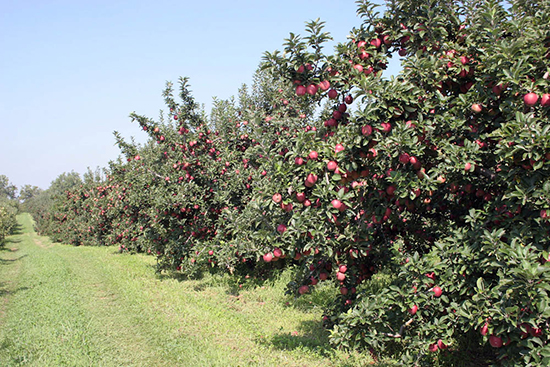Apples
Over the past 60 years Kentucky growers have produced apples (Malus domestica) using freestanding trees in low- to medium-density plantings. While these larger trees on semi-standard rootstocks are hardy, long-lived and widely adapted, they are also lower yielding and less efficient to manage. Today’s high-density orchards have closely planted trees on dwarfing rootstocks requiring permanent support structures. Earlier production, quicker returns on investment, and improved fruit quality are just a few of the many benefits of new high-density systems. Growers, however, who do not have an excellent site or a source of water for drip irrigation should not consider high-density plantings.
Marketing
 Kentucky’s fresh apple production is mainly intended for retail, with very few growers selling a large percentage of production at wholesale prices. Wholesale apple production is likely profitable in Kentucky when growers receive a fresh price over $0.25 per pound. The national average fresh apple grower price ranged from $0.30 to $0.45 from 2006 to 2016. Farm retail (direct marketing) prices in Kentucky were in the $1.50 range. Both wholesale and retail price trends point to likely profitability for well-managed and excellently marketed apple plantings in Kentucky. There is a strong demand for locally grown, full-flavored, quality apples, especially varieties not commonly available in supermarkets. Direct marketing, value-added processing (cider), and entertainment farming are market channels that often contribute to apple profitability. Farmers markets, U-Pick, and roadside stands are good direct markets for selling apples. Value-added apple products (fried apple pies, preserves, etc.) are very popular with Kentucky consumers. Restaurants are interested in local apples, and apples have been successfully wholesaled in farm-to-school marketing programs.
Kentucky’s fresh apple production is mainly intended for retail, with very few growers selling a large percentage of production at wholesale prices. Wholesale apple production is likely profitable in Kentucky when growers receive a fresh price over $0.25 per pound. The national average fresh apple grower price ranged from $0.30 to $0.45 from 2006 to 2016. Farm retail (direct marketing) prices in Kentucky were in the $1.50 range. Both wholesale and retail price trends point to likely profitability for well-managed and excellently marketed apple plantings in Kentucky. There is a strong demand for locally grown, full-flavored, quality apples, especially varieties not commonly available in supermarkets. Direct marketing, value-added processing (cider), and entertainment farming are market channels that often contribute to apple profitability. Farmers markets, U-Pick, and roadside stands are good direct markets for selling apples. Value-added apple products (fried apple pies, preserves, etc.) are very popular with Kentucky consumers. Restaurants are interested in local apples, and apples have been successfully wholesaled in farm-to-school marketing programs.
Production
 Select cultivars that produce quality fruit, perform reliably, and satisfy the characteristics demanded by potential customers. Cultivars differ in such horticultural traits as fruit characteristics (e.g. size, color, flavor and intended use), harvest period (early, mid- and late -season), as well as disease and insect resistance. Tree size, which is determined by the rootstock, may be dwarf, semi-dwarf, semi-standard or standard. Consult University of Kentucky Extension horticulture specialists and state research trial results for information on cultivars best suited for your locale and market.
Select cultivars that produce quality fruit, perform reliably, and satisfy the characteristics demanded by potential customers. Cultivars differ in such horticultural traits as fruit characteristics (e.g. size, color, flavor and intended use), harvest period (early, mid- and late -season), as well as disease and insect resistance. Tree size, which is determined by the rootstock, may be dwarf, semi-dwarf, semi-standard or standard. Consult University of Kentucky Extension horticulture specialists and state research trial results for information on cultivars best suited for your locale and market.
See the full crop profile and other resources below:
CCD Apples Profile (CCD-CP-2) (pdf)
CCD Economic Considerations for Apple Production in Kentucky (CCD-FS-14) (pdf)
Pest & Disease
- Controlling Apple Pests (UK Entomology)
- Apple Fruit Diseases Appearing at Harvest PPFS-FR-T-02 (UK Plant Pathology)
- Apple Scab PPFS-FR-T-13 (UK Plant Pathology)
- Crown Gall PPFS-GEN-01 (UK Plant Pathology)
- Fire Blight PPFS-FR-T-12 (UK Plant Pathology)
- Fire Blight of Apple Video (UK Plant Pathology)
- Frogeye Leaf Spot, Black Rot, and Canker of Apple PPFS-FR-T-03 (UK Plant Pathology)
- IPM Scouting Guide for Common Problems of Apple (2.6 MB) ID-219 (UK Plant Pathology)
- IPM Scouting Guide for Common Problems of Apple mobile website (UK Plant Pathology)
- Rust of Apple Video (UK Plant Pathology)
- Rust Diseases of Apple PPFS-FR-T-05 (UK Plant Pathology)
Larger Scale
- Apple Production: Best Management Practices ID-137 (UK Plant Pathology)
- Commercial Apple Fungicide Schedule Worksheet PPFS-FR-T-19 (UK Plant Pathology)
- Commercial Fruit Pest Management Guide (1.5 MB) ID-232 (UK Plant Pathology)
- Fungicides for Tree Fruits PPFS-FR-T-11 (UK Plant Pathology)
- Midwest Tree Fruit Pest Management Handbook ID-93 (UK Plant Pathology)
- Profile of Commercial Apple Production in Kentucky 2017 (17 MB) link (UK Plant Pathology)
- Rootstocks for Kentucky Fruit Trees HO-82 (UK Plant Pathology)
Smaller Scale
- Backyard Apple Disease Management Using Cultural Practices (with Low Spray, No Spray & Organic Options) PPFS-FR-T-21 (UK Plant Pathology)
- Bagging Apples for Pests (UK Entomology)
- Disease and Insect Control Program for Homegrown Fruit in Kentucky including Organic Alternatives ID-21 (UK Plant Pathology)
- Fruit, Orchard, and Vineyard Sanitation PPFS-GEN-05 (UK Plant Pathology)
- Home Fruit Disease Management: Apple & Pear video (UK Plant Pathology)
- Homeowner's Guide to Fungicides PPFS-GEN-07 (UK Plant Pathology)
- Kentucky Backyard Apple Integrated Pest Management Manual IPM-9 (UK Plant Pathology)
- Midwest Home Fruit Production Guide (5.7 MB) pdf (UK Plant Pathology)
- Rootstocks for Kentucky Fruit Trees HO-82 (UK Plant Pathology)
- Simplified Backyard Apple Spray Guides PPFS-FR-T-18 (UK Plant Pathology)
- Simplified Fungicide Guide for Backyard Fruit PPFS-GEN-08 (UK Plant Pathology)

